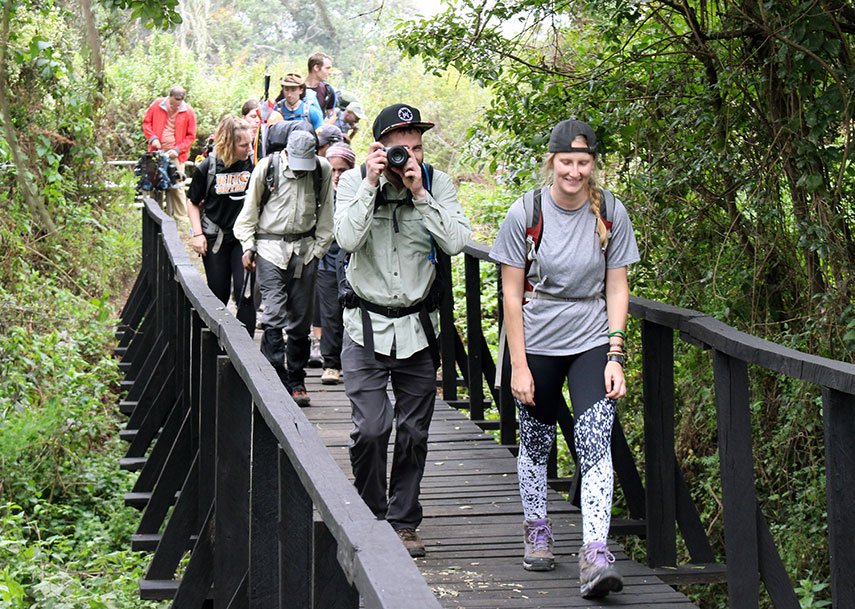Best Time to Climb Mount Kilimanjaro
Climbing Mount Kilimanjaro is a remarkable adventure that requires careful planning, especially when considering the timing of your trek. Selecting the optimal period not only enhances your experience but also significantly impacts your chances of reaching the summit safely. This comprehensive guide explores the optimal times to climb Kilimanjaro, examining weather patterns, trail conditions, crowd levels, and other key factors to help you make an informed decision.
Understanding Kilimanjaro’s Climate Zones:
Mount Kilimanjaro’s diverse ecosystems are categorized into distinct climate zones, each offering unique conditions:
- Cultivation Zone (800 – 1,800 meters):
Weather: Warm and humid, with temperatures ranging from 20°C to 30°C (68°F to 86°F) during the day. Rainfall: Significant rainfall, especially during the long rains (March to May) and short rains (November to December), resulting in lush vegetation.
- Rainforest Zone (1,800 – 2,800 meters):
Weather: Cooler temperatures, ranging from 15°C to 25°C (59°F to 77°F), with high humidity. Rainfall: High precipitation throughout the year, leading to muddy and slippery trails.
- Heath and Moorland Zone (2,800 – 4,000 meters):
Weather: Cool temperatures between 10°C to 20°C (50°F to 68°F) during the day, with colder nights. Conditions: Exposed to strong winds and variable weather patterns.
- Alpine Desert Zone (4,000 – 5,000 meters):
Weather: Arid conditions with temperatures ranging from 5°C to 15°C (41°F to 59°F) during the day, and freezing temperatures at night. Conditions: Minimal precipitation, but occasional snow or frost is possible.
- Arctic Zone (Above 5,000 meters):
Weather: Extremely cold, with temperatures often well below freezing. Conditions: Harsh environment with little to no precipitation, primarily snow.
Optimal Months for Climbing Kilimanjaro:
Weather: Generally dry with clear skies, offering excellent visibility.
Pros: Trails are less crowded compared to the mid-year peak season, providing a more peaceful trekking experience.
Cons: Occasional rain is possible, but generally manageable.
Recommendation: Ideal for climbers seeking favourable weather and a quieter environment.
June to October:
Weather: Dry and clear conditions, with cooler temperatures, especially at higher altitudes.
- Pros: Optimal climbing conditions with excellent visibility and stable weather.
- Cons: Colder temperatures at night and higher altitudes; trails are busier due to peak season.
- Recommendation: Best for climbers seeking ideal weather conditions and a vibrant trekking atmosphere, though be prepared for crowds and colder temperatures.
September and October:
- Weather: Mild and dry, with pleasant temperatures and mostly clear skies.
- Pros: Balanced weather conditions with fewer crowds compared to peak season.
- Cons: Variable weather; occasional rain is possible but generally less disruptive.
- Recommendation: Suitable for climbers seeking favorable conditions without the peak season crowds.
Months to Approach with Caution:
April and May:
Weather: Characterized by the long rainy season, with heavy and persistent rainfall.
- Pros: Lush green landscapes and fewer climbers.
- Cons: Slippery and muddy trails, challenging climbing conditions, and higher chances of cloud cover obstructing views.
Recommendation: Not ideal for most climbers due to challenging conditions; suitable only for those prepared for wet and difficult trekking.
November:
Weather: Short rains occur during this month, bringing lighter but still significant precipitation.
- Pros: Quieter trails with fewer climbers.
- Cons: Increased chances of rain, leading to muddy and slippery trails.
- Recommendation: Suitable for experienced trekkers comfortable with wet conditions and seeking solitude.
Additional Considerations:
- Full Moon Climbs:
Some climbers prefer to summit during a full moon to experience the peak illuminated by moonlight. To align a climb with a full moon, planning is essential, as the full moon occurs once a month. A 7-day climb should start 5 days before the full moon date to maximize moonlight during the summit attempt. However, be aware that full moon dates attract many climbers, leading to busier trails.
Crowd Levels:
The popularity of Kilimanjaro means that you’re unlikely to have the mountain all to yourself, especially during peak seasons. June to September are the busiest months to climb Kilimanjaro, attracting climbers from around the world. If you’re looking for a quieter experience, consider climbing during the shoulder seasons in late March and late May.





